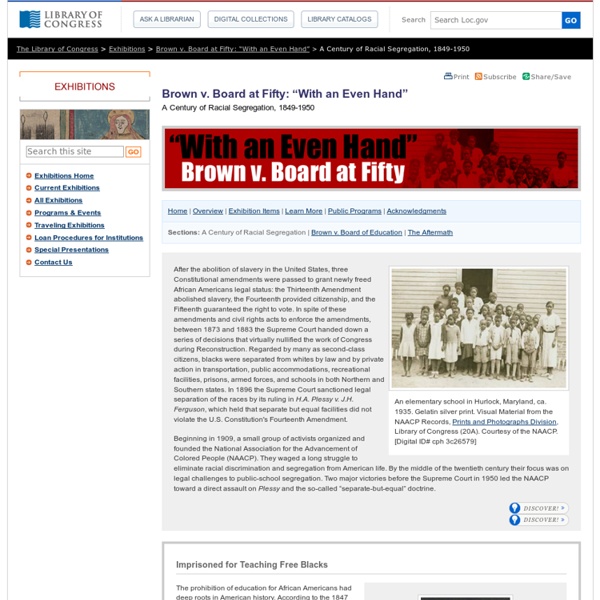The KKK and racial problems
The Ku Klux Klan was basically based in the south of America. Here they targeted those set free after the American Civil War - the African Americans. The KKK had never considered the former slaves as being free and terrorised Africa American families based in the South. America experienced great economic prosperity during the 1920's but not much of it filtered to the South. Many different groups had emigrated to America over the years. A meeting of the KKK in 1922 The leader of the KKK in the 1920’s was a dentist called Hiram Wesley Evans whose name in the KKK was Imperial Wizard. The Black Americans tried to fight back using non-violent methods.
Black Civil Rights….America in the 1950′s | Peacemakervoices's Blog
The Black Civil Rights Movement (CRM) campaigned to end Racism and Inequality for black people between 1955 and 1968. Before the CRM many towns and cities in America were segregated- black people could not use the same building entrance as a white person, eat in the same cafe, sit in the same taxi or use the same drinking fountain. Not only that, the police, judges and juries were all white and the laws supported these inequalities. The CRM challenged not only the laws but people’s attitudes- attitudes that saw black people being treated as inferior citizens because of the colour of their skin. People like Martin Luther King Jr used non-violent civil disobedience to challenge laws that enforced segregation. People sat at lunch counters they weren’t meant to, travelled on buses that were for white people and ignored segregation rules. Supported by the then President, John F Kennedy, the movement grew and laws began to change. Like this: Like Loading...
Martin Luther King Jr.
Martin Luther King, Jr., (January 15, 1929-April 4, 1968) was born Michael Luther King, Jr., but later had his name changed to Martin. His grandfather began the family's long tenure as pastors of the Ebenezer Baptist Church in Atlanta, serving from 1914 to 1931; his father has served from then until the present, and from 1960 until his death Martin Luther acted as co-pastor. Martin Luther attended segregated public schools in Georgia, graduating from high school at the age of fifteen; he received the B. In 1954, Martin Luther King became pastor of the Dexter Avenue Baptist Church in Montgomery, Alabama. In 1957 he was elected president of the Southern Christian Leadership Conference, an organization formed to provide new leadership for the now burgeoning civil rights movement. At the age of thirty-five, Martin Luther King, Jr., was the youngest man to have received the Nobel Peace Prize. Selected Bibliography Adams, Russell, Great Negroes Past and Present, pp. 106-107. Recommended:
The 1950-60's Black Civil Rights Movement in America
The actions of the 1900's black civil rights movement, and a brief outline of the events that occurred. America is advertised as the world's greatest democracy, the land of freedom and equality. However, as little as 40 years ago this slogan was far from the truth. African-Americans were discriminated against constantly, tortured and killed for no other reason than their skin color. This was the period of the Black Civil Rights movement, which saw the birth of many modern-day heroes such as Martin Luther King. MLK was looked up to due to his non-violent protest based on the teachings of the Bible and Mahatma Gandhi. The first real success of the Black Civil Rights movement was the attempt to desegregate primary schools in a case called "Brown vs Board". In 1st December 1955, a national hero was introduced whom would prove to be a very big component in the Black Civil Rights movement. Non-violent protests were starting to gain in power, due to the successful Montgomery Bus Boycott.
Black History Month
Black History Month, also known as African-American History Month in America, is an annual observance in the United States, Canada, and the United Kingdom for remembrance of important people and events in the history of the African diaspora. It is celebrated annually in the United States[1] and Canada[2] in February and the United Kingdom[3] in October. History Negro History Week (1926) The precursor to Black History Month was created in 1926 in the United States, when historian Carter G. From the event's initial phase, primary emphasis was placed on encouraging the coordinated teaching of the history of American blacks in the nation's public schools. At the time of Negro History Week's launch Woodson contended that the teaching of black history was essential to ensure the physical and intellectual survival of the race within broader society: Black History Month (1976) United Kingdom (1987) Black History Month was first celebrated in the United Kingdom in 1987. Canada (1995) Criticism See also
Racism Still Divides Black and White America | The Center for Public Justice
May-June 1991 A Discussion with Tom Skinner PITTSBURGH—[The featured speaker at this year's jubilee Conference, February 22-24, sponsored by the Coalition for Christian Outreach, was evangelist Tom Skinner. Late Saturday night in the hotel lounge, Mr. Skinner engaged several conferees in a heated discussion about racism in contemporary America. Question: Why do so many black Americans experience discrimination today after so much progress in civil rights reform over the last four decades? Skinner: African Americans made the mistake of buying the message of "the American melting pot under God." African Americans let the white majority into their political and economic lives without whites letting African Americans into their lives. Question: But what about changes in the law—after Supreme Court decisions such as Brown vs. Skinner: There were only three major Supreme Court decisions that affected African Americans. Question: Why? Question: Whose idea was integration? Question: Why?




The racial differencies between whites and blacks and whites and aboriginals were present and significant at that time, and sadly still remaining a bit today. Discrimination towards couloured people is not now abolished by the Human Rights Chart published in 1949, after the Segregation. by gagnonseguinzilio Oct 31